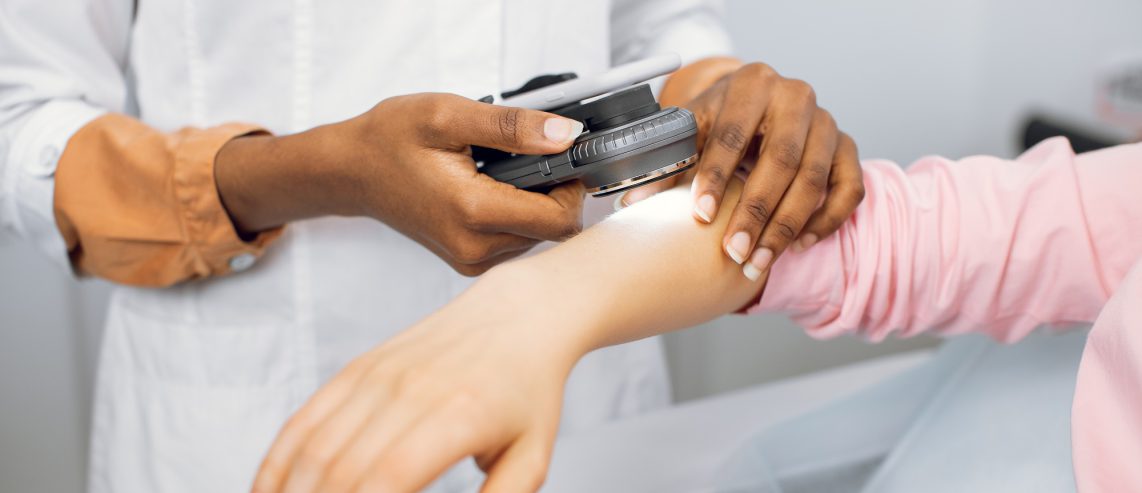Squamous cell carcinoma is a common skin cancer that grows in the skin’s top and middle layers. Left untreated, squamous cell carcinoma can grow large and deep or spread to other body parts.
Squamous cell carcinoma can be aggressive and disfiguring but it’s usually not life-threatening. The Skin Cancer Foundation reports that 15,000 Americans die each year from squamous cell carcinoma. Doctors diagnose about one million cases of squamous cell carcinoma in the U.S. each year.
Never Miss a Beat!
Subscribe to Our HealthBeat Newsletter!
Thank you for subscribing!
You can now select the specific newsletters you'd like to receive.
You are already subscribed.
Subscribe to more newsletters in our email preference center.
Sorry, an error occurred. Please try again later.
Get Healthy Tips Sent to Your Phone!
Limit Your Sun Exposure
To limit your squamous cell carcinoma risk, you need to limit your exposure to both natural sunlight and tanning beds. Both contain harmful ultraviolet (UV) rays that damage skin.
Too much exposure to UV rays damages the DNA inside skin cells. This damage leads to abnormal changes known as mutations. These mutations can lead to skin cancer, including squamous cell carcinoma.
Given the sun’s role, it makes sense that most squamous cell carcinomas grow on sun-exposed skin. Common locations include:
- Face
- Lips
- Ears
- Scalp
- Arms
- Hands
But squamous cell carcinomas also can grow on body parts not exposed to the sun. This includes inside the mouth, on the bottom of the feet, and even on the genitals. People of color are more likely to develop these “out of the way” skin cancers, but we don’t understand why. It’s possible that an immune system weakness may be involved in these cases. Solid organ transplant also is a risk factor for some people.
The best way to protect yourself is to limit your sun exposure and avoid tanning beds. Also, wear sunscreen year-round, even when you don’t expect to spend much time outdoors.
What Does Squamous Cell Carcinoma Look Like?
Examine your skin regularly. If you find anything unusual like a sore or scab, watch it for changes. See your doctor for sores that don’t heal within a couple months. Also, be on the lookout for scaly skin patches that linger, even if they look normal.
The American Cancer Society cautions that squamous cell cancers can appear as:
- Red patches with a scaly surface that might crust or bleed.
- Raised growths or lumps, sometimes with a lower center.
- Open sores that don’t heal. They may have oozing or crusted areas. Suspicious sores may also heal and then come back.
- Wart-like growths with rough surfaces.
The American Academy of Dermatology recommends regular full-body skin checks by a dermatologist. Your doctor will suggest a schedule based on your skin type and history of sun exposure.
Your doctor will want to see you more often if you have a history of squamous cell carcinoma. Those with a history of other skin cancers or disorders, like basal cell carcinoma or actinic keratosis, also need more frequent checks.
How Is Squamous Cell Carcinoma Treated?
If your doctor suspects you have skin cancer, they will start by taking a biopsy. That means removing some or all of the suspicious growth. The removed tissue will go to a laboratory for further examination.
If the biopsy shows that the growth is cancerous, your doctor will create a treatment plan. Several factors will be considered, including the tumor’s size, location, and depth.
Your doctor may suggest one of these minor surgical treatments:
- Excision — Your doctor cuts out the skin cancer and stitches the skin together.
- Mohs surgery — A specially trained dermatologist removes a single layer of skin and immediately examines it under a microscope. If the doctor sees any signs of cancerous cells, they remove another layer of skin. This process continues until there are no signs of the cancer.
- Curettage and electrodessication — Your doctor scrapes away cancer cells using a small tool. They then use electricity to kill any remaining cancer cells.
- Cryosurgery — Your doctor kills the cancer cells by freezing them with liquid nitrogen. When the spot heals, the diseased skin flakes away.
- Photodynamic therapy — Your doctor uses a light-activated chemical to kill skin cancer cells.
If your squamous cell carcinoma is small and localized, this may be all the treatment you need. However, if your skin cancer is large or has spread deep into your skin, you might need:
- Radiation therapy — Precisely targeted high-energy beams kill cancer cells. Your doctor may use radiation after or instead of surgery depending on your overall health.
- Immunotherapy — The Skin Cancer Foundation estimates that 5% of squamous cell carcinomas become life-threatening. If so, your doctor might recommend powerful anticancer drugs like chemotherapy, targeted drug therapy, or immunotherapy.
Although squamous cell carcinoma is common, good sun sense can help you prevent it. And a pattern of regular skin self-checks and professional skin checks should catch any problems early.
Sources
About UPMC Hillman Cancer Center
When you are facing cancer, you need the best care possible. UPMC Hillman Cancer Center provides world-class cancer care, from diagnosis to treatment, to help you in your cancer battle. We are the only comprehensive cancer center in our region, as designated by the National Cancer Institute. We have more than 70 locations throughout Pennsylvania, Ohio, and New York, with more than 200 oncologists – making it easier for you to find world-class care close to home. Our internationally renowned research team is striving to find new advances in prevention, detection, and treatment. Most of all, we are here for you. Our patient-first approach aims to provide you and your loved ones the care and support you need. To find a provider near you, visit our website.
